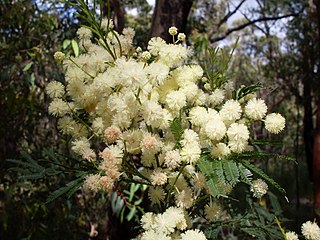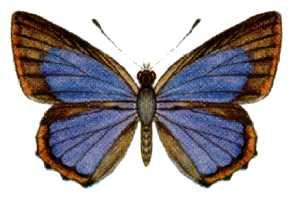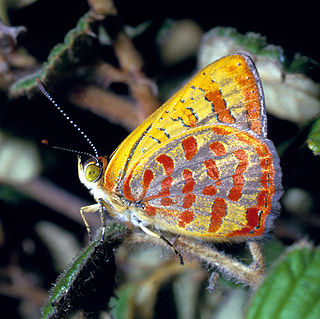
Acacia parramattensis, commonly known as Parramatta wattle, is a tree of the family Fabaceae native to the Blue Mountains and surrounding regions of New South Wales. It is a tall shrub or tree to about 15 m (49 ft) in height with phyllodes instead of true leaves. These are finely divided bipinnate. The yellow flowers appear over summer. It generally grows in woodland or dry sclerophyll forest on alluvial or shale-based soils, generally with some clay content.

Acacia decurrens, commonly known as black wattle or early green wattle, is a perennial tree or shrub native to eastern New South Wales, including Sydney, the Greater Blue Mountains Area, the Hunter Region, and south west to the Australian Capital Territory. It grows to a height of 2–15 m (7–50 ft) and it flowers from July to September.

The Luciini are a tribe of butterflies in the family Lycaenidae.

Hypochrysops is a genus of butterflies in the family Lycaenidae first described by Cajetan Felder and Rudolf Felder in 1860. This particular genus is exclusive to the Australian area with only a few species straying into Papua New Guinea.

Hypochrysops narcissus, the Narcissus jewel, is a member of the family Lycaenidae of butterflies.

Hypochrysops halyaetus, the western jewell, is a member of the family Lycaenidae of butterflies. It lives in Australia.

Hypochrysops epicurus, the dull jewel, is a butterfly of the family Lycaenidae found in Australia.

Hypochrysops byzos, the yellow-spot jewel, is a member of the family Lycaenidae. Its range consist of eastern Australia. The wingspan of both the male and female is about 3 cm.

Titea is a genus of butterflies in the family Lycaenidae.

Myrmecodia beccarii, ant-house plant, is an epiphytic plant on Melaleuca trees and others with spongy bark in the wetlands and mangroves of tropical north Queensland, Australia from Cooktown to Mission Beach. The prickly, swollen stems develop natural hollows which are invaded by the golden ant in a symbiotic arrangement. The ants patrol the plant, removing leaf-eaters, while their excreta is absorbed by the plant for nutrition.

Dendrophthoe vitellina, commonly known as long-flowered- or apostle mistletoe, is a hemiparasitic plant of the mistletoe family Loranthaceae. The genus Dendrophthoe comprises about 31 species spread across tropical Africa, Asia, and Australia. Despite being collected by Joseph Banks and Daniel Solander in 1788, and depicted in Banks' Florilegium, it was not until 1860 that it was described by Ferdinand von Mueller as Loranthus vitellinus after being collected near Ipswich, and renamed by Philippe Édouard Léon Van Tieghem in 1895.

Hypochrysops dinawa is a species of butterfly of the family Lycaenidae. It is found from southern New Guinea to Papua New Guinea.

Hypochrysops resplendens is a species of butterfly of the family Lycaenidae. It is found on Aru.

Hypochrysops delicia, the moonlight jewel, is a member of the family Lycaenidae. It is found in eastern Australia.

Hypochrysops architas is a butterfly of the family Lycaenidae endemic to the Solomon Islands. It was first described by Hamilton Herbert Druce in 1891.

Muellerina celastroides, common names Banksia mistletoe and coast mistletoe, is a hemiparasitic aerial shrub in the family Loranthaceae. The species is endemic to New South Wales, Victoria and Queensland.














